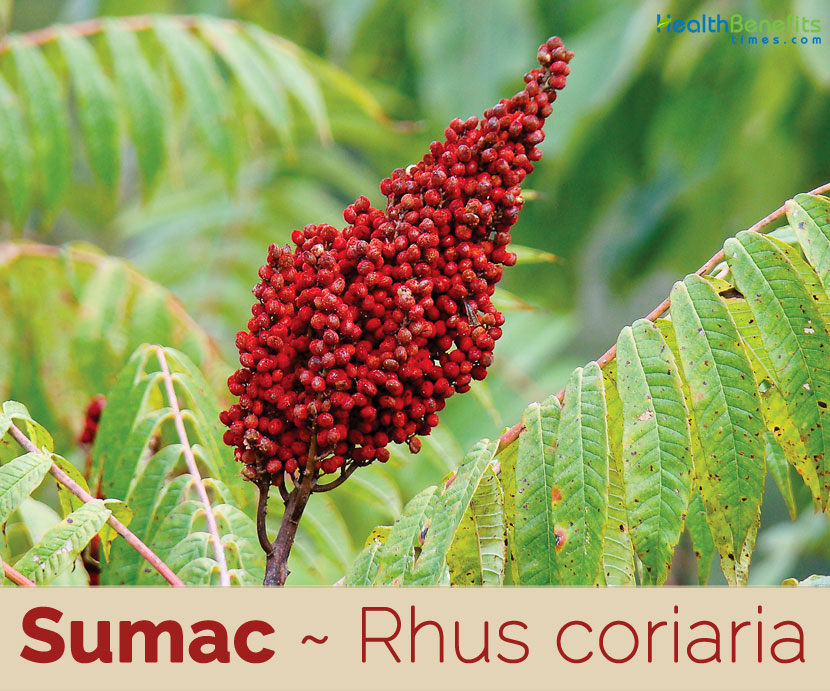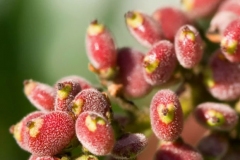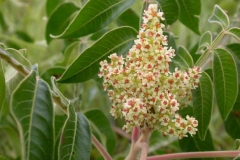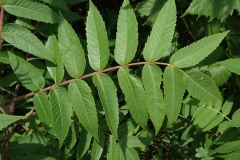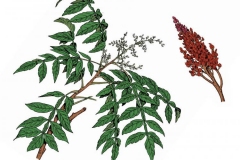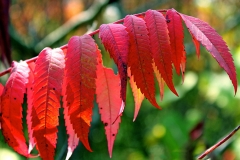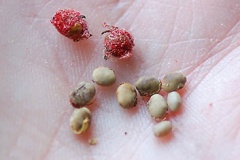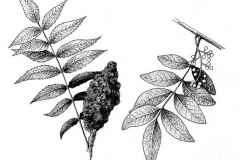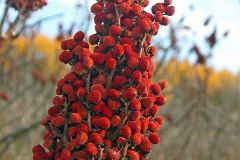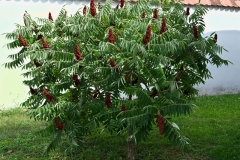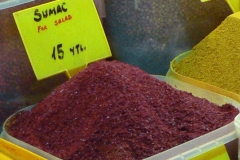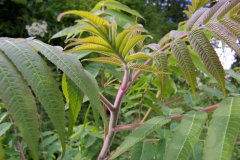The name of that plant, sumac, came from the Aramaic language and it means red. The plant has both nutritional qualities and medicinal values as it is used as a spice by crushing and mixing the dried fruits with salt, and is commonly used as a medicinal herb in the Persia, Mediterranean and Middle East, Turkey, Palestinian population, Golan Heights, Israel, Jordan, Medieval and Ottomon al-Sham region, Cyprus during island’s Ottomon period, and in the Jewish community of Medieval Cairo. Broad range of nutritionally and medicinally significant phyto-chemical components have been identified from various parts of sumac such as tannins, flavonoids, anthocyanins, organic acids, flavones, proteins, fiber, volatile oils, nitrates, and nitrites. The plant also possesses minerals which are beneficial in the treatment of different disorders and contribute to various biological processes. The plant has been used as a spice, condiment, appetizer, and as a souring agent for centuries.
Plant Description
Sumac is a dioecious shrubs and small trees in the family Anacardiadeae that grows about 1–10 m (3.3–32.8 ft.) tall. The plant is found growing in rocky places and waysides and normally prefers deep and well-drained soil. The plant has light gray or reddish stems which exude a resin when cut. Young branches are hairy. The leaves are usually pinnately compound, though some species have trifoliate or simple leaves. Leaves are 10-20 cm long, leaflets 5-7 pairs, sessile, oblong to ovate, serrate-dentate and villous beneath. Panicles are 10-20 cm long, terminal or axillary. They are hairy on the underside. In autumn the leaves turn to a bright red. Flowers are in dense panicles or spikes 5–30 cm (2.0–11.8 in) long, each flower very small, greenish, creamy white or red, with five petals. The flowers are in dense panicles or spikes 5–30 cm (2.0–11.8 in) long, each flower very small, greenish, creamy white or red, with five petals. Flowering normally takes place from July to August. Fertile flowers are followed by reddish, globose, villose thin-fleshed drupes covered in varying levels of hairs at maturity and form dense clusters at branch tips, sometimes called sumac bobs.
Health Benefits of Sumac
With its tangy, lemon-like flavor and vibrant red hue, sumac spice is a superstar ingredient that deserves a spot in every spice cabinet. Besides adding a zip of flavor and color to dishes, this powerful spice has also been related with a wide set of benefits. Thanks to its rich content of polyphenols and flavonoids, adding a dash of sumac into your diet may help lower cholesterol levels, stabilize blood sugar and even reduce bone loss. Listed below are some of the popular health benefits of sumac
1. Boosts heart health
The concentration of omega-3 fatty acids and docosahexaenoic acid in heart, kidney and brain cell tissue was increased with supplementation of thyme. Other studies looking at effects of thyme on the brain cells found that it had significant changes in brain development of rats under study. However, research is still undergoing to determine if sumac has positive effects on the brain.
2. Aids in digestion
Sumac herb is helpful in the treatment of common digestive disorders, including stomach upset, acid reflux, constipation, feverish symptoms, and irregular bowel movements. It is supposed to contain both antimicrobial and antioxidant effects.
3. Fight with Cancer
Some studies have shown that the sumac plant has anti-cancer properties. If you are a smoker, you may be able to reduce your risk of developing lung cancer by using a combination of chemotherapy and radiation therapy. It is supposed that breast cancer protects healthy cells during treatment. As a result, sumac has been regarded as a promising chemotherapeutic agent for cancer chemotherapy.
4. Powerful Antioxidant
Sumac has powerful antioxidants that fight against bad cells that damage healthy cells. According to a scientific study, antioxidants fight against bad cells responsible for heart diseases, premature aging, stomach disorders, and many other adverse events.
5. Beneficial For Women’s Health
Sumac juice, sumac tea, sumac bark is traditionally used to treat women’s diseases. Sumac is also applied externally in extreme vaginal discharge. Also, the mother’s milk also increases. It helps treat menstrual disorders, cramps, menstrual burns, and pain by acting like estrogen.
6. Good for Diabetes
Research has shown that the sumac plant is effective in the treatment of diabetes and obesity. According to laboratory results, sumac, a very powerful antioxidant, helps to reduce cholesterol and blood sugar levels.
7. Antimicrobial
Sumac is known to have naturally occurring compounds with antimicrobial activities. Research has shown that it has been found to work against a number of pathogens, including Salmonella bacteria. The rich water-soluble tannins found in it are well documented for their antimicrobial properties and have been used for these benefits since primitive times.
8. Reduces the chance of bone depletion
Bone loss, or osteoporosis, is a common condition considered by weak bones and increased risk of fractures, caused by loss of bone mass. The risk of bone loss increases progressively with age, and the Centers for Disease Control and Prevention estimate that close to 25% of women over the age of 65 suffer from this phenomenon in the neck and lumbar spine. Although research into the possible effects of sumac on bone health is very limited, one study found some promising and encouraging results.
9. Calms muscle aches
If you suffer from chronic muscle pain, sumac in your spice cabinet can help to treat the problem. In fact, a study conducted at the University of Mansoura in Egypt revealed that Sumac juice, which can be brewed from tanner’s sumac, can help reduce muscle pain during aerobic exercise in healthy adults. Thanks to the rich antioxidant content of sumac, it can also help reduce the risk of inflammation and thus provide additional relief from pain. Studies conducted in 2009 show that inflammation not only contributes to the development of various diseases, and plays a major role in the development of autoimmune disease – cell death and destruction of tissues in the body in different areas, but also contributes to the sense of strong pain.
10. Alleviate Common Respiratory and Digestive Issues
The Sumach herb has been widely used to treat chest and respiratory issues. These include cough, chest congestion and bronchitis for a very long time. This is due to its potent volatile oils (thymol, carvacrol, Borneo, and geraniol) that have been scientifically proven to work.
The berries of the popular herbal plant can also reduce fever. Mixing the potent herbal remedy with honey will make a super effective yet natural cough syrup. Sumac can treat various common digestive issues. These include constipation, irregular bowel movements, acid reflux, and stomach upset. The potent herb can also be mixed with onion to form a delicious appetizer.
https://www.youtube.com/watch?v=O-vPqgneM2c
Traditional uses and benefits of Sumac
- Leaves and the seeds are astringent, diuretic, styptic and tonic.
- They are used in the treatment of dysentery, hemoptysis and conjunctivitis.
- The seeds are eaten before a meal in order to aggravate an appetite.
- It is traditionally used and also clinically investigated for lipid lowering effects.
- Fruits consist of tannins and are astringent.
- Powdered fruits are eaten as a treatment for diarrhea.
- This plant has been used in the treatment of diarrhea, dysentery, ulcer, hemorrhoids, hemorrhage, wound healing, hematemesis, hemoptysis, leucorrhea, sore throat, ophthalmia, conjunctivitis, diuresis, animal bites, poison, pain, and liver diseases.
- Traditional medical practitioners have also used sumac for cholesterol reduction, in the treatment of sore throat, and as an abortifacient.
- Powder of its bark is effective for cleaning the teeth.
- Bark infusion is useful in beginning of viral eye infections.
- Bark is bruised in water and applied on the forehead for the first-aid treatment of epistaxis.
- Powdered fruits are sprinkled on boiled egg and eaten for the treatment of diarrhea.
- Decoction of fruits is prepared and administered orally for the treatment of liver disease, diarrhea and urinary system disorders.
- Seeds when consumed before the intake of food will provoke hunger.
Culinary Uses
- Immature fruits are used as caper.
- Crushed fruit, mixed with Origanum syriacum, is a principal ingredient of ‘Zatar’, a popular spice mixture used in the Middle East.
- Seed is used as an appetizer in a similar manner to mustard.
- Fruits (drupes) of Rhus coriaria are ground into a reddish-purple powder used as a spice in Middle Eastern cuisine to add a tart, lemony taste to salads or meat.
- Immature fruits and seeds are also eaten.
- Seeds and fruits are used as a flavoring in many traditional dishes in Kurdistan, and as a spice in Anatolia.
Other facts
- Leaves and bark are rich in tannin.
- Leaves can be collected as they fall in the autumn and used as a brown dye or as a mordant.
- Leaves contain 20 – 35% tannin and yield a yellow dye.
- Finely ground leaves and stems provide the dyeing and tanning agent sumac.
- Fawn color, bordering on green, is obtained and this can be improved with the judicious use of mordents.
- Oil is extracted from the seeds.
- It attains a tallow-like consistency on standing and is used to make candles. These burn brilliantly, though they emit a pungent smoke.
- Black dye is obtained from the fruit.
- Yellow and a red dye are obtained from the bark.
- Leaves and bark of most sumac species consists of high levels of tannins and have been used in the manufacturing of leather by many cultures around the world.
- Dried fruits of some species are ground to produce a tangy, crimson spice popular in many countries.
- Fruits are also used to make a traditional “pink lemonade” beverage by steeping in water before straining to remove hairs which may irritate the mouth or throat, sometimes adding sweeteners such as honey or sugar.
- Some beekeepers use dried sumac bobs as a source of fuel for their smokers.
- Leaves and the bark were traditionally used in leather tanning and contain tannic acid.
Things to keep in mind
Despite all the benefits of consuming sumac on our bodies, it is important to know some facts and warnings about its consumption
Allergic reactions
Since sumac comes from the same plant family of cashews and mangoes, you should consult a doctor if necessary before you ingest sumac, as those who are allergic to cashews and mangoes will probably suffer from similar symptoms after consuming sumac.
Unwanted weight loss
Although most of us agree that this is actually an advantage, those of us who are underweight or have a problem maintaining normal body weight, we recommend that you avoid eating sumac daily. The reason for this is anti-lipase activity – an enzyme that speeds up the breakdown of oils and fats, which partly blocks the absorption of fat in the small intestine.
Safety in pregnancy
Some herbs and spices are best avoided during pregnancy because some include uterine stimulants that may disrupt menstruation, which may increase the risk of miscarriage. The powerful antioxidant in it, quercetin, which has been found to help treat cancer, can lead to complications in pregnancy and childbirth. Thus, it is recommended during pregnancy to avoid the consumption of sumac, at least until studies on the subject claim otherwise.
Biological activities of different used parts of Sumac (Rhus coriaria)
| Sumac Quick Facts | |
|---|---|
| Name: | Sumac |
| Scientific Name: | Rhus coriaria |
| Origin | Subtropical and temperate regions throughout the world, especially in East Asia, Africa, and North America |
| Colors | Green when young turning to red as they mature |
| Shapes | Reddish, globose, villose thin-fleshed drupes covered in varying levels of hairs at maturity |
| Taste | Tangy, lemon-like flavor |
| Health benefits | Boosts heart health, Aids in digestion, Fight with Cancer, Powerful Antioxidant, Beneficial For Women’s Health, Good for Diabetes, Antimicrobial, Reduces the chance of bone depletion, Calms muscle aches, Alleviate Common Respiratory and Digestive Issues, |
| Pharmacological
Properties |
Plant part
used |
Used extract/plant
part (form) |
Result/Activity |
|
Antibacterial activity |
Fruits | Hydro-distilled extract | Demonstrated a desirable antibacterial activity |
| Fruits | Ethanol and methanol extracts | Sumac extracts were effective against Gram positive and Gram negative bacteria | |
| Fruits | Ethanol 95% extract | Significant antibacterial activities against all tested species have been shown | |
| Fruits | Methanol extract | A strong in vitro antioxidant activity indication of the methanolic extract of sumac fruits | |
| Fruits | Water extract solution extract 0.8:10 (wt./vol) | Bacteriostatic/bactericidal effects by bacteria cycle reduction exerted by sumac extract have demonstrated | |
| Plant | Water, Methanol 80 %, Ethanol 80 % extracts | Antibacterial activity can be exerted individually or conjointly with other spice | |
| Fruits | Ethanol 80% extract | Effective antibacterial agents on both Gram-positive and Gram-negative bacteria | |
| Plant | Ethanol extract | R. coriaria extract can have an antimicrobial effect on total microbial and Salmonella count in minced meat for one week | |
| Leaves | Ethanol 95% extract | Showed a high antibacterial activity in comparison with other plants | |
| Plant | Ethanol 80% extract | Sumac extracts exhibited a moderate activity on Brucella strains | |
| Fruit | Ground and fermented sumac | R. coriaria could decrease the formation of biofilm, a major virulence factor in staphylococcal infections | |
| Plant | Ethanol extract | Results indicated that among other plant extracts, the sumac one, was found to have the most potent against: Propioni-bacterium acnes, S. aureus, E. coli, P. aeruginosa | |
| Fruit | Ethanol 20% extract | A remarkable inhibitory activity was shown by sumac extract against B. cereus. Also it strongly inhibited the growth of H. pylori. The fruit extract exhibited a good antioxidative capacity, justifying its use as a natural antibacterial preservative | |
| Plant | Water extract | Sumac water extracts showed the strongest antibacterial activity among other 10 extracts studied. | |
|
Antioxidant activity |
Fruit Epicarp | Methanol extract | From results it can be noted a desirable antioxidant activity of sumac which in turn could delay the oxidation of palm oil |
| Plant | Ethyl acetate and 80% methanol fractions after initial defatting by petroleum ether | The ethyl acetate fraction of plant materials exhibited a noticeable antiradical activity on DPPH | |
| Fruits | Methanol extract | Results indicate a strong in vitro antioxidant activity of the methanolic extract of Rhus coriaria fruit based on hydroxyl radical scavenging | |
| Fruits | Water extract | Sumac extract was more effective than BHT, and could be added to meat products (e.g. sausage)to enhance quality | |
| Fruits | Methanol 70% extract | Sumac extracts and fractions showed remarkable antioxidant activity against inhibition of lipid peroxidation and scavenging activity based on DPPH radical assay. | |
| Aerial Parts | Methanol 50% extract | Desirable antioxidant activity was shown | |
| Fruits | Ethanol and water extracts | Water extracts of sumac with effective antioxidant and radical scavenging activities as compared to ethanol extracts. | |
| Fruits | Ethanol 20% extract | Sumac fruit extract exhibited a good antioxidative capacity also it showed a remarkable inhibitory activity against B. cereu, besides it strongly inhibited the growth of H. pylori. | |
| Plant | Water extract | Sumac water extracts showed the strongest antioxidant activity among other 10 extracts | |
|
Anti-diabetic activity |
Fruits | Methanol extract after fractionation with ethyl acetate and hexane | Ethyl acetate fraction of sumac fruits showed appreciable biological activity through α-amylase inhibition indicating significant hypoglycemic activity. |
| Fruits | Ethanol 96% | The Sumac extract raised markedly HDL and also reduced LDL, increasing superoxide dismutase and catalase activities. Also, it inhibited maltase and sucrase activities. | |
| Fruits | Ethanolic extract | Anti-diabetic activity in vivo: Alloxan-induced diabetic wistar rats | |
| Seeds | Methanol extract | Anti-diabetic effect of Sumac on blood glucose and glycosylated hemoglobin levels in NIDDM rats. | |
| DNA-Protect activity | Fruits | Sumac extract in water solution | Sumac showed to be a potent antioxidant which may protect humans against oxidative DNA-damage suggesting gallic acid as main contributor for Sumac effects |
|
Lipid-lowering and hypo-cholesterolic activity |
Fruits | Methanol 80% and 100% extracts | Sumac fruit extract was of use in decrease the high serum lipid levels, and moderate the elevated cardiac lipid concentrations. |
| Fruits | Dietary supplement Sumac fruits, and methanol 80% extracts | Decrease in cholesterol in the blood of rabbits resulted after the oral administration of sumac during 90 days, showing thus a positive effect on cholesterol and VLDL levels in adult male rabbits | |
| Fruits Powder | Dietary Sumac powder oral administration | Dietary supplementation of sumac, reduces the blood VLDL-c, TC, and FBS concentrations in broiler chicken | |
| Fruits Powder | Fat diet with 2% of Sumac powder | A protective effect of consuming sumac with food on some risk factors of atherosclerosis and oxidative stress (LDL-C, total cholesterol) has been demonstrated | |
| Fruits | Dietary Sumac powder oral administration | Sumac can be useful to decrease the negative effects of mild heat stress on broiler chickens due to its richness in tannins. | |
|
Anti-migratory activity |
Fruits | Acetone 70% extract | Tannin extract from Sumac has an inhibitory role on the migration of VSMC and suggesting an athero-protective role. |
| Fruits | Dietary Sumac powder oral administration | Acute consumption of Sumac might be having protective effects on some risk factors of atherosclerosis, and liver enzymes, due to high fat food stress | |
| Leaves | Ethanol extract | Moderate antifungal activity was found for Sumac |
Recipes
Harissa-roasted monkfish with blood orange, sumac, pomegranate and za’atar flatbread
Ingredients
For the monkfish
- 1 tbsp. crème fraîche
- 1 tbsp. harissa
- 1 lemon, juice only
- 600 g/lb 5 oz monkfish fillets
For the flatbread
- 350 g/12 oz. plain flour
- 1 tsp. salt
- 2 tsp. fresh yeast
- 300 ml/½ pint warm water
- pinch sugar
- 120 ml /4¼ oz. plain yogurt
- 150 ml/¼ pint olive oil
For the salad
- 1 pomegranate, seeds removed
- 1 bunch fresh mint
- 1 bunch fresh coriander
- 2 blood oranges, segmented, juice reserved
- 2–3 tsp. sumac, to taste
- 2 tbsp. pomegranate molasses
- 3 tbsp. olive oil
Ingredients for the zaatar
- 2 tsp. sesame seeds
- 2 tsp. dried oregano
- 2 tsp. dried marjoram
- 2 tsp. sumac
- 1 tsp. salt
- 2 tsp. cumin
- 3–4 tbsp. extra virgin olive oil
Instructions
- For the monk fish, mix the crème fraîche, harissa and lemon juice together in a bowl large enough to accommodate the monk fish. Spread the marinade over the fish, cover and refrigerate for 2 hours.
- For the flatbread, mix the flour and salt in a large bowl. Soften the yeast in the warm water with the sugar. Add to the flour along with the yogurt and olive oil. Knead for 15 minutes, or until the dough is smooth and elastic. Cover and rest in a warm place until doubled in size (this will take about an hour).
- Divide the dough into balls approximately the size of tennis balls. When ready to use, roll into flat rounds.
- Cook in a dry, hot frying pan until blistered on both sides. Wrap in tea towels and keep warm in a low oven until ready to serve.
- Preheat the oven to 250 C/230 C Fan/Gas 9.
- For the monk fish, scrape off most of the marinade and place on a baking tray. Roast for 6–8 minutes, depending upon the thickness. Set aside to rest.
- While the monk fish is resting, combine all the salad ingredients in a bowl.
- To serve, mix the zaatar ingredients together with the olive oil to make a loose paste. Spread some of the zaatar mixture over the flat breads and lay on a serving boards or plates. Scatter the salad over the top and slice the monk fish to scatter over.
Fattoush salad
Ingredients
For the salad
- 100 ml/3½fl oz. vegetable oil
- 2 pitta breads, cut into squares
- 2 large vine tomatoes, chopped into large chunks
- ½ cucumber, chopped into large chunks
- 1 Little Gem lettuce, leaves separated and torn
- 2 fresh mint sprigs, leaves picked and finely chopped
- large handful fresh parsley, finely chopped
- 10–12 black olives, pitted
- ½ pomegranate, seeds only
- salt and freshly ground black pepper
For the dressing
- 1 lemon, juice only
- 2–3 tbsp. extra virgin olive oil
- 2 tbsp. pomegranate molasses
- 1 tsp. sumac, plus extra to garnish
Instruction
- Heat the vegetable oil in a deep-fat fryer until it reaches about 170 C, or a cube of bread browns in 30 seconds. (Caution: Hot oil can be dangerous. Do not leave unattended.)
- Deep-fry the pitta bread for 2–3 minutes, or until golden-brown. Drain on kitchen paper and sprinkle with sea salt.
- To make the dressing, whisk the ingredients together in a small jug. Season with salt and pepper.
- To make the salad, place the tomatoes, cucumber lettuce, herbs and olives in a large bowl. Pour over the dressing and mix well.
- Scatter with the fried pitta, pomegranate seeds and a sprinkle of sumac before serving.
References:
https://www.itis.gov/servlet/SingleRpt/SingleRpt?search_topic=TSN&search_value=506465#null
https://npgsweb.ars-grin.gov/gringlobal/taxonomydetail.aspx?id=31683
https://pfaf.org/user/Plant.aspx?LatinName=Rhus+coriaria
http://www.floracatalana.net/rhus-coriaria-l-
https://en.wikipedia.org/wiki/Sumac
http://tn-grin.nat.tn/gringlobal/taxonomydetail.aspx?id=31683
https://www.wikidata.org/wiki/Q159546
https://wikivisually.com/wiki/Rhus_coriaria
https://plants.usda.gov/core/profile?symbol=RHCO14
https://en.wikipedia.org/wiki/Rhus_coriaria
http://nittygrits.org/Rhus_coriaria-ln
http://temperate.theferns.info/plant/Rhus+coriaria
http://www.theplantlist.org/tpl/record/kew-2422872
http://www.catalogueoflife.org/col/details/species/id/03acc6d0d1d4888c4a144874fb237429
http://www.maltawildplants.com/ANCR/Rhus_coriaria.php
https://gd.eppo.int/taxon/RHUCR
http://www.naturalmedicinalherbs.net/herbs/r/rhus-coriaria=elm-leaved-sumach.php


